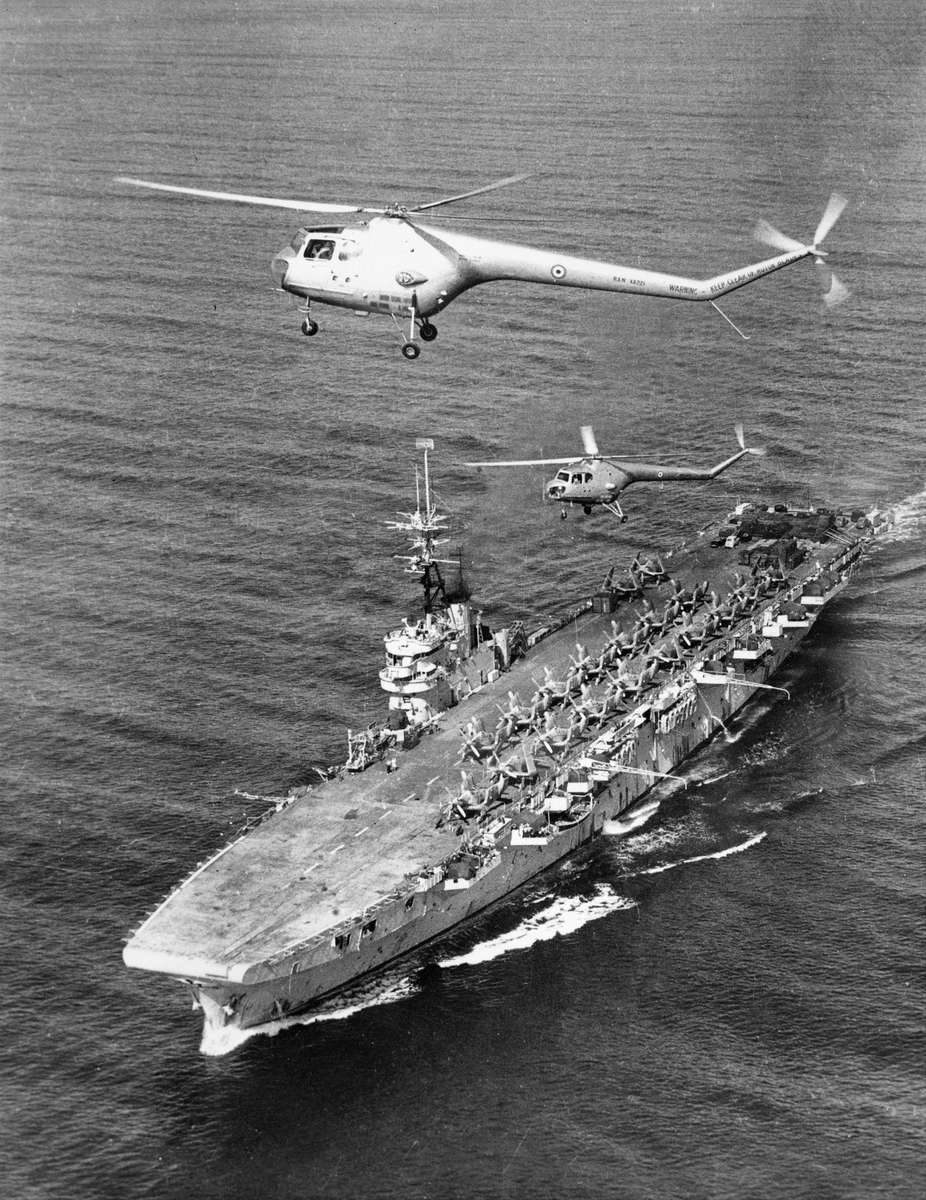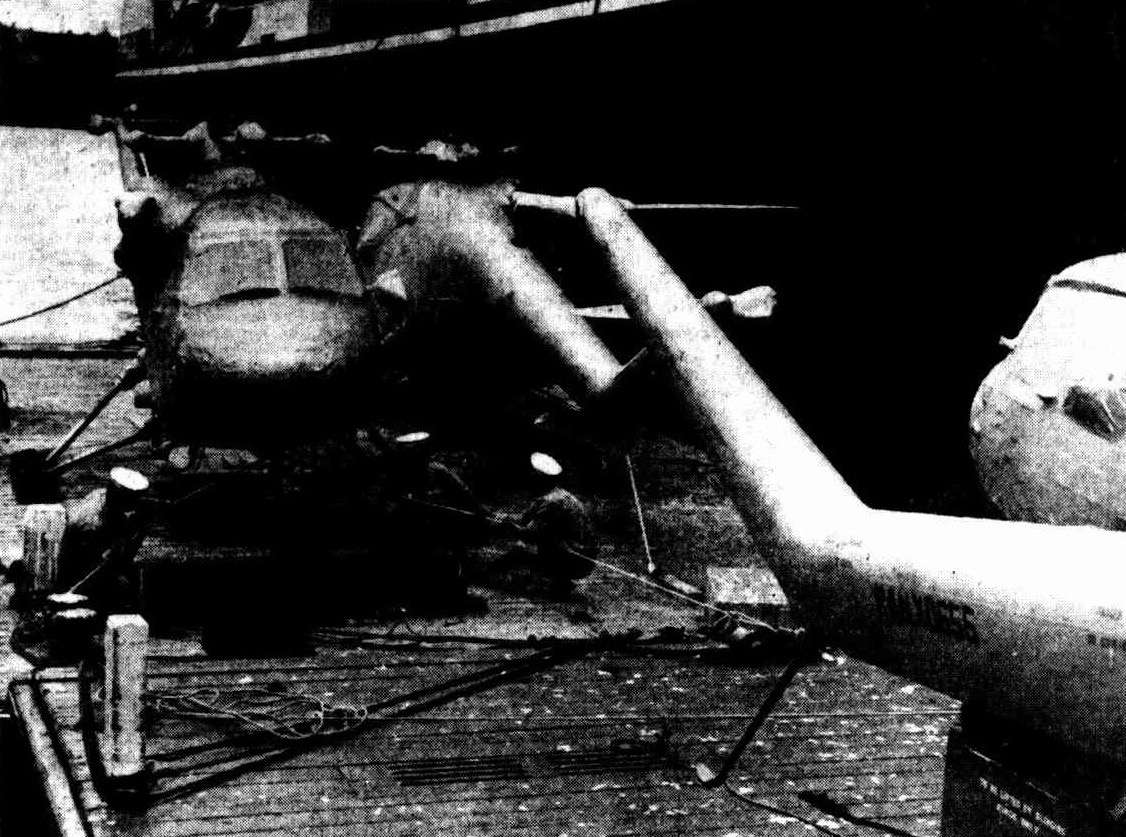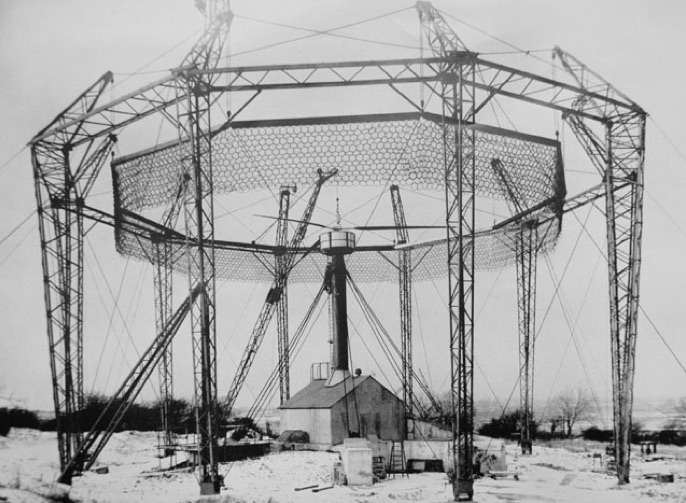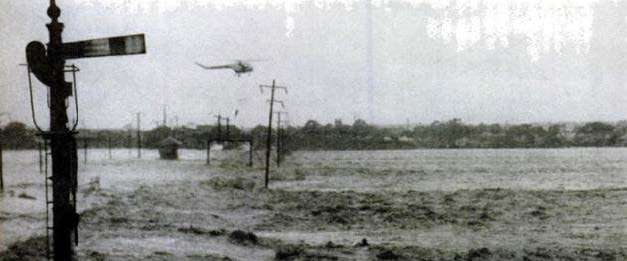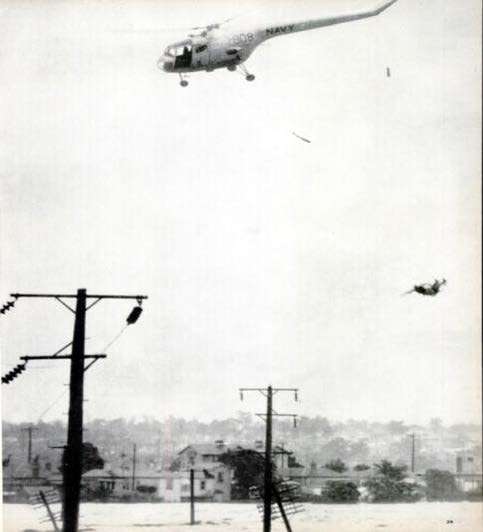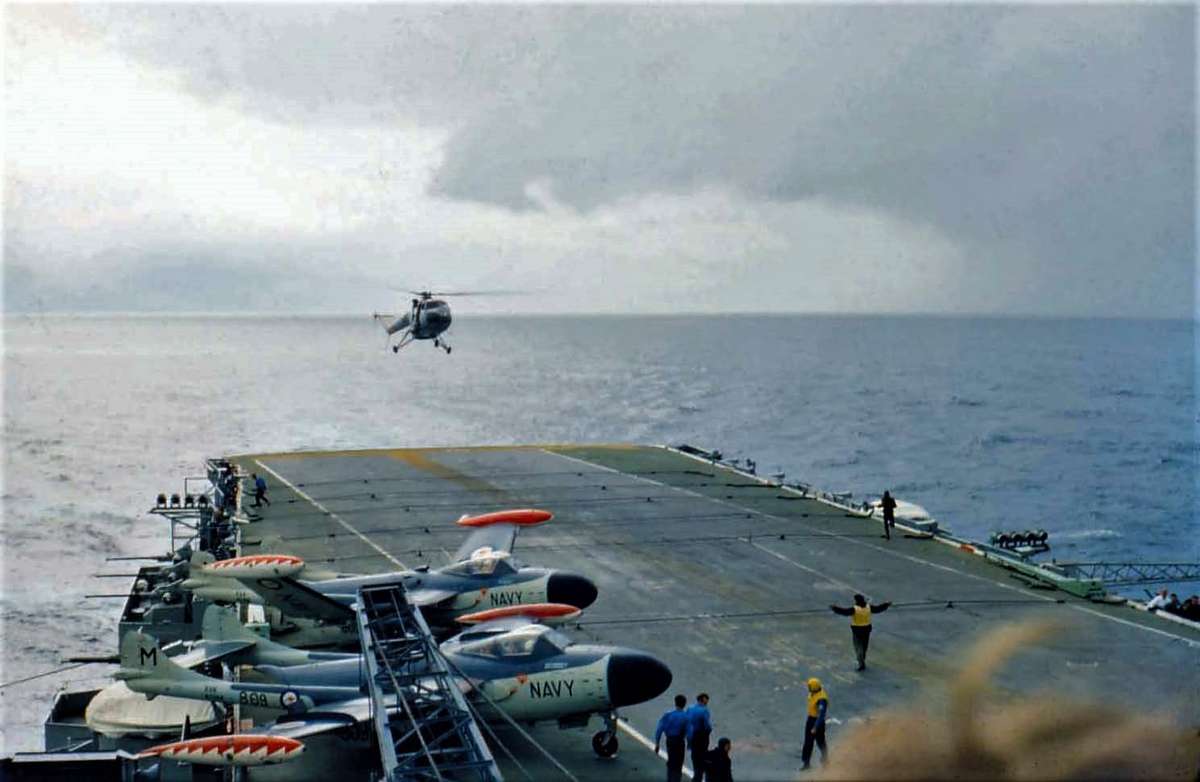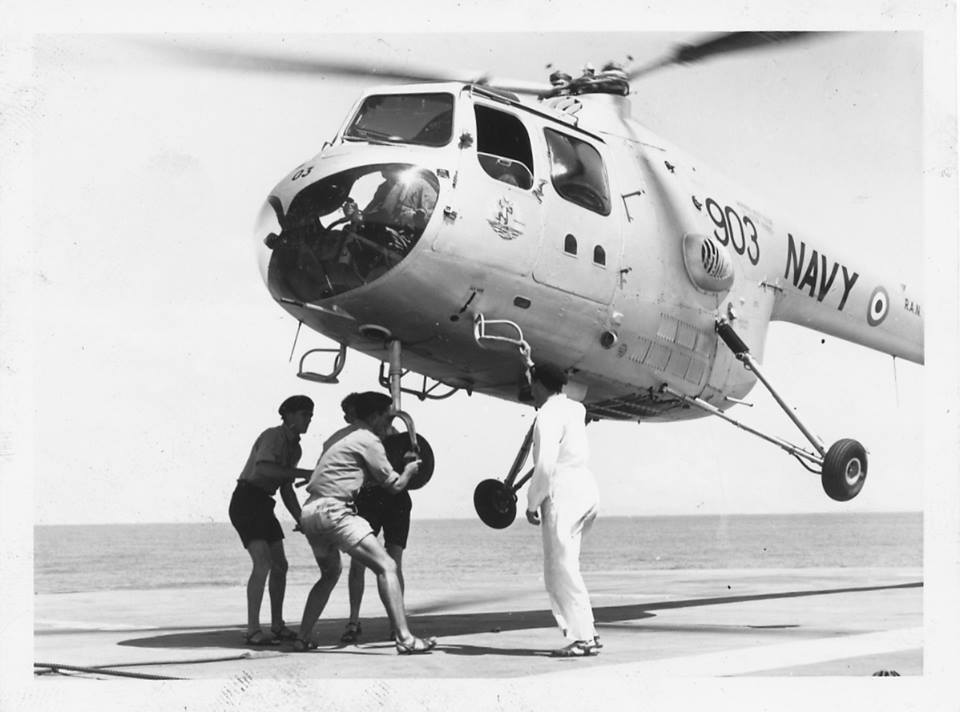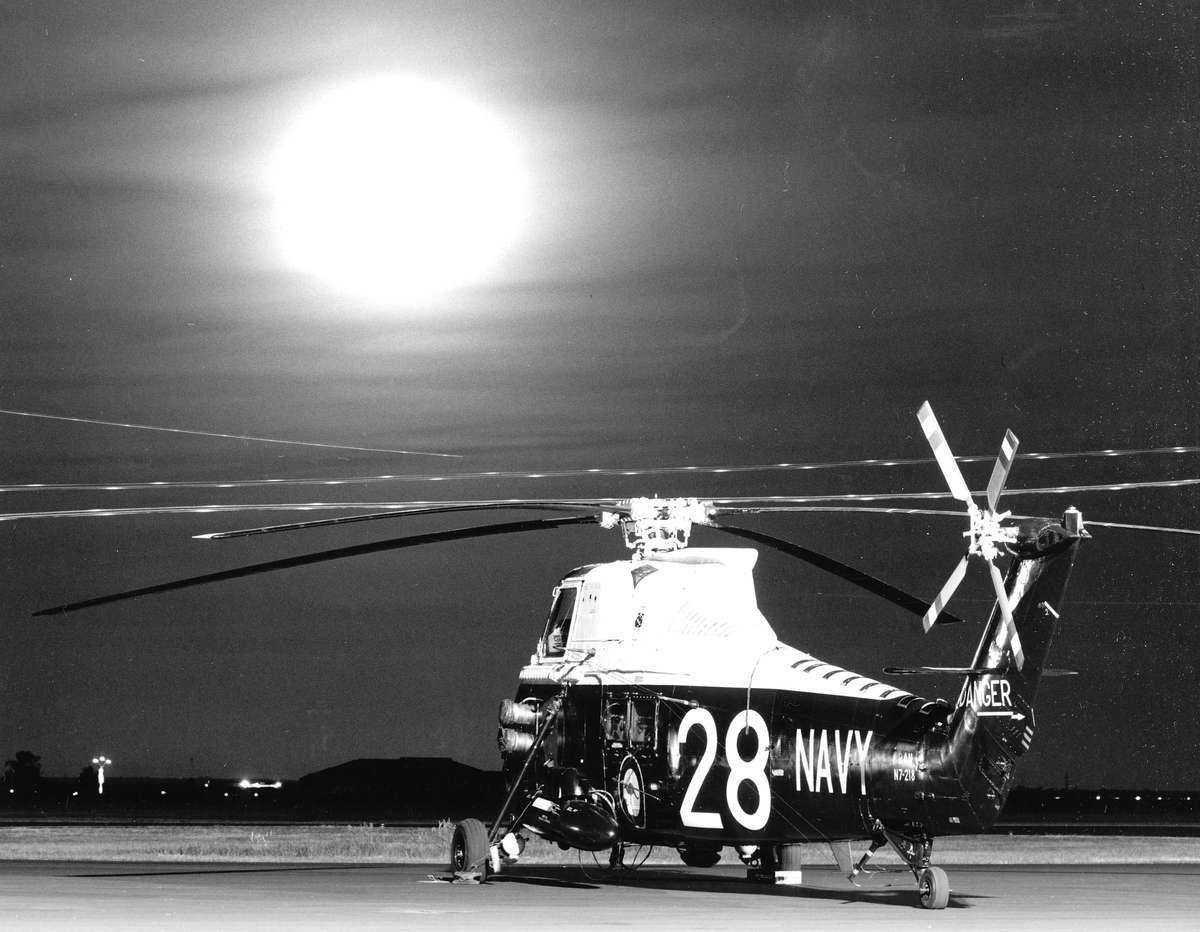The Sycamore was hardly a good looker, with its pod-like fuselage, spindly legs and long tapered tail. And it wasn’t the easiest machine to fly, either – being variously described as temperamental, underpowered and unforgiving.
But it was arguably one of the most important aircraft in the RAN’s Aviation History, as it not only brought an immediate new capability to the Fleet, but set the RAN on the long road of developing rotary wing skills and know-how which became the foundation of today’s complex operations.
When RAN Fleet Air Arm was formed in 1948 the plan included two light-fleet carriers. The first, HMAS Sydney, was delivered with two Supermarine Type 309 ‘Sea Otter’ amphibian biplanes, for Search And Rescue work. By then, however, advances in helicopter design had rendered the ‘Sea Otter’ obsolete in this role and the search for a replacement began.
During the Korean War, USN Sikorsky HO3S-1s and RN Westland WS-51 Dragonfly helicopters flew SAR and plane guard duties while attached to HMAS Sydney. The versatility and advantages of those machines made it clear that helicopters were to be an indispensable part of naval aviation’s inventory. This view was sealed by the stunningly successful rescue of two downed FAA aircrew from behind enemy lines by the ship’s borrowed Sikorsky.
Before deciding on the Bristol Sycamore, the RAN surveyed a range of helicopter types. While it was noticed the RAAF had ordered two Sycamores for operations at Woomera; several factors influenced the RAN in also selecting the Sycamore. For example: they could operate by day or night and were equipped with a hydraulic winch; and their range and payload also allowed for medivacs, passenger and freight transport, pilot training, and fleet support tasks.
Another feature of the Sycamore was the folding main rotor blades, allowing them access to the hangar deck of an aircraft-carrier; furthermore the use of strong hydronalium alloy in the airframe (resistant to seawater corrosion) was an asset. Also, the Sycamore’s top speed was high (for the era), they were cleared for tropical use, and were well-suited to RAN needs.
The Sycamores Arrive
In 1951 the RAN placed an order for three HR 50 helicopters with Bristol Aircraft Limited, Filton, England. The Australian HR.50 was similar to the RAF HR.13 SAR model, but had taller and stronger landing gear for shipboard operations. On 16 January 1953 the first three (XA219 to XA221) were flown aboard HMAS Vengeance in the UK, arriving in Australia on 11 March – and were assigned to 723 Squadron. Vengeance was on loan from the RN until 1956, then replaced by HMAS Melbourne which ferried two more Sycamores HR 51s (XK902 & XL507) from the UK on her maiden voyage to Australia. Eight more Sycamore HR 51s were shipped to Sydney on merchant vessels, the last arriving in June 1961.
Left and above. The first three Sycamores arrived on the loan carrier HMAS Vengeance. The photo to the left appeared in the Sydney Morning Herald of 12 March 1953 with the caption: “Two Bristol Sycamore helicopters hover over the aircraft carrier HMAS Vengeance, which arrived in Sydney yesterday from England… This picture was taken from the Vengeance’s third helicopter by a staff photographer who travelled on board from Melbourne.” Right. Other RAN Sycamores were delivered by commercial shipping, as in this case. The poor quality image appeared in the SMH of 20Nov54, with the caption: “These four unusual-looking Bristol Sycamore helicopters were unloaded from the freighter Braeside at Darling Harbour yesterday. The RAN bought the helicopters from the RN for £50,000 each. the helicopters were covered with a protective coating to guard against rust and corrosion.” (Trove).
Technical notes (performance figures subject to conditions)
Manufacturer:Bristol Aircraft Limited, Filton, England
Type:Bristol Sycamore HR 50/51 variants
Number delivered: 13 units – first 1953 last 1961
Crew:Pilot, co-pilot, and winch operator. [or 2 in the cockpit & 3 passengers in the cabin]
Engine:Alvis Leonides 524/1, 9-cylinder, air-cooled radial, 500/520 hp, 370/390 kw
Max. speed: 110 knots (203 km/h, 125 mph) at sea level
Cruising speed: 79 knots (146 km/h, 99 mph)
Range:233 nm (431 km, 268 miles)
Endurance:3 hr
MTOW:2,540 kg (5,600 lbs)
Service ceiling: 4600 m (15,000 ft)
Main Rotor diameter: 14.81 m (48 ft 7 in.)
Length blades folded: 14.07 m (46 ft 2 in.)
Length blades spread incl tail rotor: 20.6 m (67 ft 6 in.)
Height to top of tail rotor disc: 4.44 m (14 ft 7 in.)
Notes: The RAN N5 serial code was never applied as the Sycamores were about to retire, so original UK serials remain. In July 1958 side numbers changed from 900 to 800 series.
Bristol Sycamore HR 50/51 Basics
The RAN Sycamore HR 50/51s were military versions of the civilian Bristol Type 171. In 1944 Bristol set up a rotary-wing division, led by engineer Raoul Hafner, producing the first British designed helicopter manufactured in series. The prototype first flew in July 1947 then, following further tests and modifications, it went into production in 1952. It was an innovative and versatile design meeting Ministry of Supply specifications. Around 180 were built – in various marks, mainly for military use in the UK, Australia, Belgium and Germany; others were the civilian Type 171.
The Bristol Sycamore layout was conventional, with a three-blade main rotor and anti-torque tail rotor, powered by a 520 bhp Alvis Leonides, air-cooled radial engine. The cockpit had two seats: one for the pilot, the other for a co-pilot or passenger. The rear cabin had three, fold-down seats for passengers. For rescue work – a crew member in the rear cabin operated a power-winch on the starboard side (max 181 kg – 400 lb); directing the pilot via intercom. The operator would hoist people to the doorway and into the cabin.
The RAN Sycamores had VHF radio, modified tricycle undercarriage – the main legs being longer and wider than standard, with a lengthened nose leg for extra ground clearance. The Sycamore could be operated in high wind (typical on a flight-deck); and a rotor brake was fitted to the transmission – all necessary for shipboard operations. A freight/baggage compartment was at the rear of the engine bay. As the Sycamore was not a weapons platform it did not carry guns or rockets.
Sycamore Training Begins
In 1952, prior to the arrival of the Sycamore HR 50 helicopters, two RAN pilots Lt Neil MacMillan and Lt Gordon McPhee were sent to the UK for helicopter instruction and conversion to the Sycamore at RNAS Gosford (HMS Siskin). They were joined by a third pilot, Lt Don Farquarson RN, on loan to the RAN as a helicopter instructor. On 16 January 1953 they landed the first three Sycamores on HMAS Vengeance near Weymouth, ready for her voyage to Australia.
On 11 March 1953 Vengeance arrived in Australia. Here the Sycamores were assigned to 723 Squadron, the Fleet Requirements Unit, stationed at HMAS Albatross (RANAS Nowra). Lt Farquarson ran the first RAN helicopter pilot training course, with the assistance of Lt McPhee and MacMillan.
Helicopter Flying Training Course
723 Squadron was a Fleet Requirements Unit based at NAS Nowra, equipped with a variety of aircraft. When the Sycamores joined 723 Squadron, they formed the first helicopter flying training school in Australia and played a long and useful role in developing helicopter skills in the RAN. The Sycamores remained with 723 during their service life (except for a short period with 724 Squadron) greatly assisting the RAN’s transition from fixed-wing to anti-submarine helicopter operations in the early 1960s.
Much of the training took place at Jervis Bay airfield away from air traffic at NAS Nowra. As the main role for the Sycamore was SAR work the focus was on precision hovering over water and land. Attention was also given to safe handling, and avoiding the traps pilots might encounter. Other exercises included adjusting for centre of gravity changes, and landing in confined spaces. Generally, it took about 10-hours instruction before pilots were ready to fly the aircraft solo; and 90-hours flying plus ground subjects to complete the course.
During the 1950s a steady stream of fixed-wing pilots did Sycamore conversion courses at NAS Nowra to build-up a core of helicopter pilots, Being an early generation helicopter and unsophisticated by today’s standards the Sycamore had its challenges and eccentricities. The shift from forward flight to the hover, the hover itself, and flying backwards were skills that required much practise. To avoid ground resonance on touchdown, firm landings and speedy use of the rotor brake were necessary. Likewise, autorotation demanded the utmost care. But, having mastered the Sycamore’s foibles, pilots enjoyed flying them.
Sycamores to the Rescue
In addition to its training role, the Sycamores were used for various transport, search and rescue, and utility tasks. Remarkably, on 23 March 1953, shortly after their arrival a call came for a Sycamore to assist a badly injured lighthouse keeper at Point Perpendicular, Jervis Bay, some 30 km from NAS Nowra. Taking care to avoid nearby telegraph wires the pilot alighted next to the lighthouse; assisted by a Naval Surgeon the casualty was quickly flown to NAS Nowra – where an ambulance took the injured man to hospital.
The Birth of the Bristol Sycamore
The Sycamore was the military derivative of civilian Type 171. The company that developed and built it, the Bristol Airplane Company, was one of the first in Britain (it was founded in 1909), and for many years was the most important manufacturer of aircraft and engines in the UK.
Unlike other companies such as Westland, Fairey and Cierva, Bristol chose to design a new helicopter altogether, using a standard configuration of a fuselage, tail and main and tail rotors. Originally conceived as a four seater (pilot and three passengers), the Bristol Type 171 Mk 1 commenced development shortly after 1944, but proceeded slowly.
Helicopter design at the time was rudimentary, so Bristol’s technicians built a series of test beds to examine the behaviour and characteristics of various components such as the main rotor. It was driven by an electric motor to measure vibration levels, issues with balance and structural integrity. Each major component was tested in this way before the first helicopter was assembled, which was then itself tested by tethering it to the ground. By then it was May of 1947.
By July of that year the first prototype was flown in Filton (Bristol) by Alan Marsh, one of the very first helicopter pilots in Britain.
On 26 May 1949 the second prototype received the first certificate of airworthiness issued by British authorities, and on the same day it became the first British-designed helicopter to fly across the English Channel.The Bristol 171 Mk. 3 followed, with significant improvements such as a more powerful and compact engine mounted horizontally; elimination of the lower gearbox; relocation of instruments; rear sliding doors and increased cabin width to accommodate three back-seat passengers. The Mk. 4 was released at the end of 1952 and became the basis of the Military version, the Sycamore. (vide Heli-Archive)
In the 1950s, the Sycamores also assisted the civil authorities covering a variety of unusual tasks. One difficult job simplified by a helicopter involved passing an electrical cable across a wide gorge near the Lucas Heights nuclear reactor. The occasional request from police could vary from providing transport and photography services to tasks such as search and rescue operations and assistance in murder investigations.
The Hunter Valley Floods
On Wednesday 23 February 1955 the NSW Hunter Valley flooded. Following an urgent call for help, The RAN flew a Sycamore from Nowra to Newcastle to assist in the rescue effort. The following day a second Sycamore flew Nowra to Dubbo. On 25 February two further helicopters from HMAS Sydney (in Melbourne at the time) flew north to the floods. Another Sycamore being serviced at Bristol’s Bankstown joined the effort. Working every day for over a week, the Sycamores delivered supplies and rescued over 100 people around Maitland, Dubbo, and Narrabri.
At the height of the floods a tragic incident occurred near Singleton, when a Sycamore attempted to rescue two men trapped on a railway signal box in danger of being swept away. They grabbed the rescue strop but fell and drowned, and the aircraft spun into the torrent below. The two aircrew were rescued 8 km downstream.
Right and Below. The Maitland Floods in early 1955 were a devastating event raging through 50 towns and leaving 70 dead. The RAN deployed Sycamores at short notice, earning the praise of the media of the day, and the gratitude of people in the region.
It was not without cost, as illustrated by the three photographs right and below. According to a local newspaper, a group of men were trapped on a signal box that collapsed just as Sycamore XA221 (flown by LCDR Gordon McPhee and LEUT Hill) reached it. Two of the men managed to grab the rescue strop at the last seconds but lost their grip as they were being hoisted, to fall to their deaths (right). Almost immediately the Sycamore also lost control and ditched into the raging waters below. McPhee and Hill were rescued after being swept some five miles downstream (Images: LIFE magazine).
Some idea of the extent of the disaster and the enormous part the RAN Fleet Air Arm played in it can be read here (scroll down to page 10).

The Versatile Sycamore
The Sycamores were based at RANAS Nowra, but variously served on the aircraft carriers HMAS Vengeance, Sydney, or Melbourne whenever they were at sea with fixed-wing squadrons embarked. The Sycamore’s main role was ‘plane guard’, hovering near the bow or stern of the carrier during catapult launches and deck landings in case of an emergency.
At sea they were also used for medical emergencies, communication duties, personnel transportation, photographic exercises, mail deliveries, and utility duties around the fleet. The Sycamores worked hard, becoming a crucial part of the carrier’s aviation component. In the 1950s helicopters were something of a novelty and the Sycamores attracted a great deal of attention, creating excitement wherever they went.
When embarked the Sycamores were greatly valued as the following indicates. In his June 1953 Report of Proceedings, the Captain of HMAS Vengeance stated: “Helicopter serviceability proved most encouraging and the single aircraft embarked was available at all times during flying. In addition to its value as a plane guard its use for general fleet requirements cannot be over-emphasised.”
Helicopter Happenings
The RAN was quick to realise the potential of helicopters. The Bristol Sycamores became the workhorses of the day, besides the search and rescue work and time saved in transferring personnel and stores at sea, they were called upon for all manner of tasks. The Air Force and Army had few helicopters until the 1960s, and few were in commercial operation. Emergency Services, Police, Ambulance/Rescue, and TV Station helicopters were years away.
Special requests for helicopter assistance were not unusual. In 1955 during a trip to New Zealand HMAS Sydney’s Sycamore was made available to transfer a dangerously ill woman from Waiheke Island to Auckland’s St Georges Hospital – attracting much favourable comment in the press.
Between 4th and 12th February 1955, during a visit to Hobart, Sycamores from HMAS Vengeance assisted the Hydro Electric Commission of Tasmania to reconnoitre rugged country in the King and Franklin River regions of Western Tasmania and Lake Mackenzie. Further afield in the Solomon Islands the resident administrator was able to survey hitherto inaccessible jungle locations with the assistance of a Sycamore from HMAS Sydney.
In 1956 a Sycamore carrying HRH The Duke of Edinburgh was flying from Government House in Sydney to Kensington, when engine problems struck. Hearing a loud bang, the Duke said, ‘what was that?’ The quick-witted pilot said, ‘That’s a rich cut, sir’ (backfire) as he feverishly nursed the helicopter towards the landing ground. Just before touch-down another bang followed. The Duke said, ‘I suppose that’s another rich cut’ to which the pilot said, ‘Yes sir, possibly something to do with the humidity in the air’. The Duke, being a helicopter pilot, himself replied ‘I won’t wear that’.
Not wishing to admit to flying a ‘dud’ helicopter the pilot remained silent as he safely landed the machine. Later, after the Duke moved to his next engagement, the Sycamore was put on a truck to Nowra where it was found that two cylinders had fractures. RAN Sycamores suffered cylinder problems on five separate occasions, prompting engine modifications.
Lacking the power of today’s helicopters, a telling moment came in 1961 when a Sycamore from HMAS Melbourne ditched during an attempt to land on HMS Hermes due to a number of circumstances, including a high aircraft all-up-weight, a crowded flight deck, tropical ambient conditions and the ship steaming down-wind while conducting a RAS. The end result was the Sycamore ran out of lift while attempting to come to the hover off the bows of Hermes. Result – a splash down, followed by rescue by Hermes sea-boat, with no injuries to the survivors. The four Lieutenant Commander passengers all out-ranked the pilot and had no hesitation in using his back and shoulders as a means of disembarking from the rapidly sinking Sycamore!
The Advance of ASW Helicopters
From the early 1950s the RAN was attuned to the development of Anti-Submarine Warfare (ASW) helicopters with ‘dunking sonar’. In October 1951 the US Navy commissioned its first ASW helicopter squadron with Sikorsky S-55s. Then in September 1953 the Royal Navy formed 706 Squadron for ASW operations; a role taken over by 845 Squadron in March 1954 using Westland Whirlwind HAS 22s. At the time the RAN was committed to using its fixed wing Fairey Gannets for ASW work and the Bristol Sycamores for plane guard and other duties. But the success of helicopters in the ASW work heralded an increased role for helicopters in the future.
While great strides had been made in the development of the hunter-killer ASW helicopter concept, the need for the Sycamores remained undiminished as they continued to provide valuable service in plane guard, training, and fleet support roles. Given the numerous instances of assistance to the civil authorities, rescue work, and attendance at air shows, the Sycamores were a vital part of naval aviation – but big changes were about to take place.
Sunset for the Sycamores
Following the 1959 government decision to disband the fixed-wing element of the RAN in 1963, there was a pause in FAA activities. But with the ‘Cold War’ and regional tensions brewing, the fixed-wing commitment was renewed and a strong anti-submarine focus adopted. In April 1961 the RAN ordered 27 Westland Wessex HAS 31A ASW helicopters from the UK. This gave the Sycamores and 723 Squadron a new importance, as the urgent need for ASW helicopter pilots meant ramping up training operations using both ab initio trainees and more experienced fixed-wing pilots.
During the late 1950s and early 60s, following initial training at HMAS Cerberus, RAN aircrew recruits were drafted to RAAF Point Cook where they joined the No 1 Basic Flying Training School as probationary pilots. The course covered flight theory, basic navigation, flying Winjeels and other fixed-wing piston aircraft. After graduating at Point Cook, pilots then transferred to RANAS Nowra to begin training with 723 Squadron flying Bristol Sycamores.
Given the low-tech nature of the aging Sycamores – this meant learning the fundamentals of flying a helicopter, without the technology and instrumentation of the new generation machines. Because the Sycamore had just one collective pitch lever mounted between the pilot’s seats, they were less than ideal for training. Also, without hydraulics or automatic stabilising equipment, piloting involved plenty of physical exercise.
The Sycamore’s idiosyncrasies meant pilots on conversion courses learnt their rotary-wing lessons the hard way. Yet, once confident, pilots developed a respect for the Sycamore, and a keen sense of what is needed to fly a helicopter effectively. The high standard of RAN helicopter pilots is testimony to the competence and skills generated during the Bristol Sycamore era. This played a notable part in the transition to the new Westland Wessex ASW helicopters that arrived at NAS Nowra in the early 1960s.
Farewell the Sycamores
The Bristol Sycamores were the first rotary-wing aircraft purchased by the RAN. They performed valuable service and established a place for helicopters in Australian naval aviation. With the arrival of the Westland Wessex HAS 31As in 1962 the Sycamores became redundant and the need for a new training helicopter was pressing. After rejecting several contenders, the replacement came in the form of the Bell UH-1 Iroquois in 1964. Yet the RAN can be proud of the outstanding service the Sycamores rendered during their 12-year tenure.
Today, the RAN uses the multi-role ship MV Sycamore for training helicopter crews in shipboard operations. It forms part of the Helicopter Aircrew Training System (HATS) and a gentle reminder of the important role the Bristol Sycamore played in the early days of rotary-wing training.
Saved Sycamores
The RAN Fleet Air Arm Museum at Nowra, south of Sydney NSW, has a Bristol Sycamore HR51 helicopter on display, with other former FAA aircraft. The Australian National Aviation Museum at Moorabbin Airport, south of Melbourne, has an ex-RAAF Bristol Type 171 Sycamore. The Camden Museum of Aviation, near Sydney, has a former RAN Sycamore, but is not open to the public. The Beck Military Museum, Mareeba Qld, had Bristol Sycamore HR51 XN450 in its collection, but the museum has since closed and the contents reportedly sold off. We have tried to contact the previous owners but have been so far unsuccessful.
References
ADF Serials. Heli-Archive. ANL – Trove
‘Flight’ magazine 1953
‘The Navy’ – March 1955
‘Flightpath’ Vol 14 Number 4
‘Flying Stations, ANAM, Allen & Unwin 1998
‘Wings Across the Sea’ Ross Gillett, 1988
‘Slipstream’ archive
The Flying Bulls – Sycamore
Bristol Aircraft Ltd type 171 catalogue
723 Squadron history
Australian War Museum – photos & ROPs
National Archives of Australia
Geoff Goodall Aviation History
The Ron Marsh Collection
Phil Thompson FAA history compendium
Wikipedia
“Weston-super-Mare and the Aeroplane” Roger Dudley and Ted Johnson. Amberley Publishing.
Email J. Da Costa (Sycamore Pilot).


